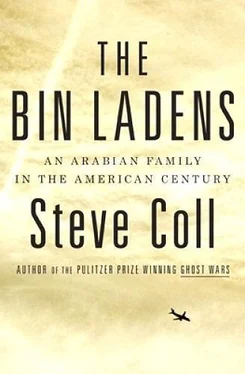THE TROUBLE STARTEDwhen an ox died.
The ox belonged to Awadh Aboud Bin Laden. Around the turn of the twentieth century, he lived in the desert village of Gharn Bashireih, in a deep canyon called Wadi Rakiyah. The gorge cut a path of fifty miles through a region of southern Arabia, in modern Yemen, called the Hadhramawt, which means “Death Is Among Us.” It was an accurate name; the land was mostly sand and rocks, baked by cyclical droughts. Barren clay bluffs rose on each side of Rakiyah’s chasm. Camels, donkeys, and goats strayed among thornbushes and scrub trees. There were perhaps forty villages scattered in the canyon’s depths; its population was no greater than ten thousand people. 1
Awadh’s house and the small patch of ground he farmed lay near a four-story rectangular turret built from mud bricks by two Bin Laden brothers, Ali and Ahmed, who probably lived during the early nineteenth century, judging by the genealogies kept by their descendants. This Bin Laden family fort rose from the highest point in Gharn Bashireih, shadowed by the canyon’s western wall. By Awadh’s lifetime, the turret, which had been used as a home by the two brothers, was eroding into a ruin; it looked like a sand castle washed over by the tide. Clusters of newer mud-brick homes encircled the hillside below the tower, forming a defensive apron. Around the village spread ten or twenty acres of flat farmland, divided into tiny plots of about ten yards by fifty yards, which various Bin Ladens owned. Farming was a precarious vocation dependent upon brief seasonal rains. After each storm, villagers rushed out to capture flood-waters and channel them into their fields. If they succeeded, they might grow wheat or other staple crops for a few months. If they failed, they might face famine. 2
Awadh Bin Laden made his fateful decision to borrow a plow ox from an Obeid tribesman after one of these cyclical rains. The Obeidis were a powerful clan who patrolled the empty plateaus above Rakiyah’s canyon and also farmed in the valley. There was, of course, no system of insurance or collateral associated with such an ox loan. When the animal died suddenly under Awadh’s yoke, his creditor, whose name was Bilawal, made what the Bin Laden family’s oral history holds to be an outrageous demand: forty silver riyals. This smacked of extortion, but while there were perhaps several hundred Bin Ladens in the village, “they were so poor they could not stand by” Awadh, said Syed Bin Laden, who still lives in Gharn Bashireih. 3
The Bin Ladens belonged to the Kenda tribe, which traced its origins to pre-Islamic Arabia and became a powerful federation in southern Hadhramawt by the seventeenth century. It had been known then as a tribe of rulers and sheikhs, but perpetual warfare gradually dissipated its strength and scattered its members. By Awadh’s time, the Kenda no longer functioned as an organized group with recognized leaders and armed militias. The Bin Ladens had become merely a family clan of perhaps four to five hundred people, clustered defensively in an ancestral fortress-village, struggling for survival. They were in no position to sustain warfare against rival groups.
The Bin Ladens divided themselves into four branches, each of which traced itself to the generation of the turret builders, Ahmed and Ali, who were two of four brothers, the others being Mansour and Zaid. Each of these brothers fathered a line of descendants who, by Awadh’s lifetime, acted together as an extended family within the wider Bin Laden clan.
Awadh belonged to Ali’s branch. The family’s oral genealogy holds that Ali was Awadh’s great-great grandfather. Little is recalled about the intervening generations except that Awadh was the only child of his father, Aboud. He therefore inherited all of Aboud’s land in Gharn Bashireih. This proved to be a very meager estate, however, and as it turned out, it was not enough to help Awadh forestall his ox creditor. 4
At first, in lieu of forty silver riyals, which he did not have, Awadh negotiated to provide Bilawal with a lien on the several acres he farmed. Bilawal agreed to accept half of the profits from Awadh’s harvests until the debt was paid. If the rains had returned, Awadh might have worked himself out of difficulty and the subsequent history of his branch of the Bin Laden family might have turned out quite differently. As it happened, however, a drought hit Rakiyah. Awadh could offer his creditor no profits in the ensuing months, which angered Bilawal. By one Bin Laden family account, Bilawal threatened to kill Awadh unless he either came up with the cash he owed or turned over full title to his land. 5
Awadh decided to abandon his ancestral village. He was a bachelor, free to travel. The drought had deepened steadily since the ox’s demise. Emigration was a common survival strategy in the Hadhramawt, even without the spur of a tribal death threat. Awadh packed his belongings and set out across the high plateau for a neighboring canyon known as Wadi Doan, about a day and a half ’s ride by camel or donkey. There he would begin again.
SHEER CLIFF WALLS of nine hundred feet or more plunge to the floor of the Wadi Doan, seventy miles inland from the Arabian Sea. Dark green date palm trees nourished by a riverbed cover the canyon’s floor. A race of giants hewed the chasm’s stones until God took umbrage at their arrogance and destroyed them with a sandstorm, according to local legend. This may explain the stunning architecture: Stacked against the rock walls rise the giant skyscrapers of fortified castle-villages, each town a gated, vertical redoubt against its neighbors. For purposes of defense there are no windows on the houses’ lower floors, and the slits higher up are designed for shooting.
To Europeans of the time, the canyons of the Hadhramawt seemed remote and filled with dangerous xenophobes; they were a “parallel, interior world…a blank on the map.” In truth, the Hadhramawt was not isolated at all, but its deeply religious inhabitants, although capable of gracious hospitality, did not always take kindly to unannounced Christian visitors. For several thousand years Hadhramis had been migrants, travelers, traders, and entrepreneurs, sailing out in wooden dhows from the port of Mukalla to the East Indies, Zanzibar, Abyssinia (modern Ethiopia), and up the Red Sea to Mecca and Cairo. For a time, centuries ago, they and their Sabean kings enjoyed enormous wealth as caravan monopolists in the global trade in myrrh and frankincense, drawn from the gum of Arabian trees. In pharaonic Egypt and during the Roman Empire, incense burned from costly frankincense and even more expensive myrrh transformed these oils into two of the most precious commodities on earth. In Rome, no god could be worshipped properly, no funeral commemorated, no respectable marriage bed entered, without the smoke of frankincense swirling through the room. Only as its empire dissolved and austere Christian preachers denounced incense as a perfume of blasphemers did the trade decline and Hadhramawt fall back into poverty. With Islam’s arrival in the seventh century, the men of the canyons sailed again as soldiers in proselytizing Muslim armies. They stayed on in the lands they conquered as bodyguards, traders, and, eventually, political notables. They remained devoted to their homeland and by the turn of the twentieth century, many prosperous Hadhramis had carried their colonial-era trading wealth back to the canyons to build retirement homes and family compounds. So many returned from Asia and Africa that when a British officer carried out the first formal survey of the gorges during the 1930s, he discovered Swahili and Malay among the local languages. 6
At the time of Awadh Bin Laden’s arrival, Britain claimed Doan as part of its Aden Protectorate, a political entity that was more wish than fact, one in a chain of loosely governed coastal territories the empire’s strategists had stitched together in Arabia to protect India’s shipping lanes from Turkish and German scheming. The local instrument of British control was the Sultan of Mukalla, who ruled from a compound of whitewashed palaces on a rock outcropping beside the Arabian Sea, protected by a personal bodyguard of African slaves. The sultan’s family had earned its fortune as mercenaries for the Nizam of Hyderabad, in India; by the early twentieth century, they preferred to spend their time in Hyderabad’s luxurious courts. In Mukalla, they left in charge a succession of wazirs , or ministers, from the Al-Mihdhar family, which hailed from the Wadi Doan. One of these deputies, Sayyid Hamid Al-Mihdhar, was recalled by a British visitor as “a smooth, oily character, outwardly jovial but with unsmiling eyes,” who used his office “to ensure preferential treatment for his fellow Doanis.” [1] Decades later, Osama Bin Laden recruited Khalid Al-Mihdhar, a member of this well-known Wadi Doan family of sayyids, or descendants of the Prophet Mohamed, as a hijacker in the September 11 plot; Al-Mihdhar piloted the plane that crashed into the Pentagon.
The Mukalla sultanate was far from a model government; to the extent it controlled the interior canyons, it did so by taking hostages from prominent local families. 7
Читать дальше












